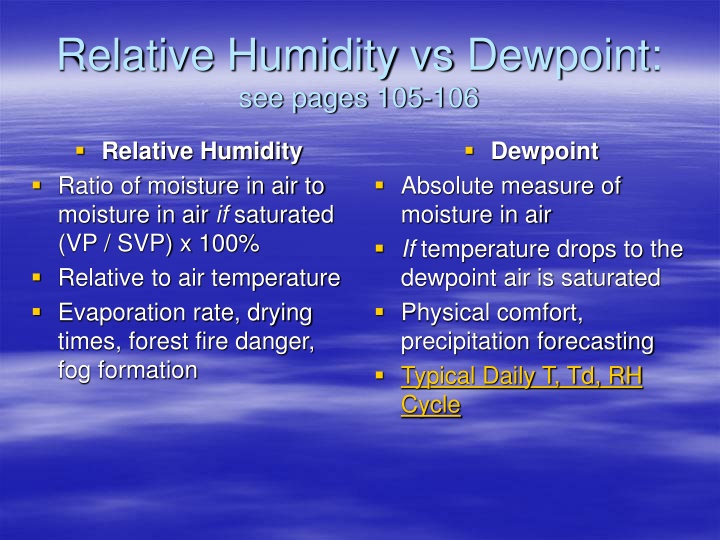
Relative Humidity, Dewpoint, and Cloud Formation
Explore the relationship between relative humidity and dewpoint, key factors influencing cloud formation, precipitation processes, and the Bergeron-Findeisen process. Learn about how air temperature, condensation nuclei, and physical comfort play a role in weather phenomena like fog, rain, and snow. Uncover the mechanisms behind precipitation and the interplay of moisture levels in the atmosphere. Visual aids help illustrate these concepts and processes for a comprehensive understanding of meteorology.
Download Presentation

Please find below an Image/Link to download the presentation.
The content on the website is provided AS IS for your information and personal use only. It may not be sold, licensed, or shared on other websites without obtaining consent from the author. If you encounter any issues during the download, it is possible that the publisher has removed the file from their server.
You are allowed to download the files provided on this website for personal or commercial use, subject to the condition that they are used lawfully. All files are the property of their respective owners.
The content on the website is provided AS IS for your information and personal use only. It may not be sold, licensed, or shared on other websites without obtaining consent from the author.
E N D
Presentation Transcript
Relative Humidity vs Dewpoint: see pages 105-106 Relative Humidity Ratio of moisture in air to moisture in air if saturated (VP / SVP) x 100% Relative to air temperature Evaporation rate, drying times, forest fire danger, fog formation Dewpoint Absolute measure of moisture in air If temperature drops to the dewpoint air is saturated Physical comfort, precipitation forecasting Typical Daily T, Td, RH Cycle
Cloud Formation Air must be cooled to saturation point (dewpoint), and then slightly below it (net condensation) Radiational cooling (dew, fog): the ground radiates away more energy than it absorbs and cools the air above it Rising Air Convection (showers, thunderstorms) Convergence into low pressure (rain, snowstorms) Orographic lifting: ram air into the side of a mountain where it is then forced to rise (windward vs leeward side, rain shadows Condensation Nuclei: surfaces upon which water can condense Salt, smoke, dust Grass blade tips, car surfaces (dew, not clouds)
Precipitation Processes How do we get from tiny cloud droplets to large raindrops or snowflakes? (See pp. 321-324) 1) Warm rain process: collision, coalescence Droplets collide and stick together to form bigger drops, which fall and collide with more droplets on the way down, forming large rain drops Tropics 2) Cold (sub-freezing) clouds Bergeron-Findeisen Process Much of the United States
Bergeron-Findeisen Process I All 3 phases of water exist in same cloud Just like water droplets need condensation nuclei, ice crystals need ice nuclei Resemble ice crystals Much less abundant than condensation nuclei This is why liquid water is found in clouds as cold as 40 degrees Thus: cloud initially has a lot of liquid water and very little ice
Bergeron-Findeisen Process II Air within the cloud is saturated, but SVP over water is higher than SVP over ice Ice molecules more tightly bonded In-cloud air is supersaturated with respect to ice and subsaturated w.r.t. liquid water Ice crystals will grow at liquid water s expense Crystals grow heavy enough to fall Shatter and create more ice nuclei, starting process anew Catch droplets on the way down and reach the ground as rain or snow icecrystal
Precipitation Formation Warm Cold
Key Figures 4.13, 4.15, 8.30, 8.31, 8.32
